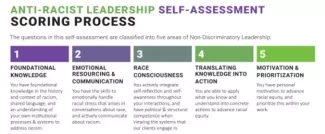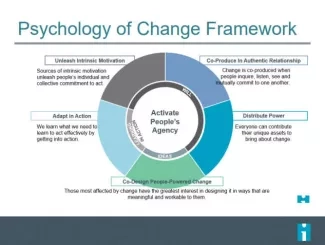Why It Matters

Photo by Helena Lopes | Unsplash
Some may view workplace equity and joy in work as separate issues, but during a recent presentation to the Institute for Healthcare Improvement (IHI) Joy in Work Results-Oriented Network (ROLN), IHI Senior Project Manager Santiago Nariño asserted that they were inextricably intertwined.
Achieving both workplace equity and joy in work, he noted, requires cultural shifts in an organization. So, instead of seeing them as separate, Nariño asked, “How can we begin to merge all of it — equity and joy in work or equity and wellness — to understand our systems in a more holistic way?”
In the following interview, Nariño describes the links between joy in work, the IHI Psychology of Change Framework, and doing anti-racism work.

Figure 1 - Anti-Racist Leadership Self-Assessment Framework (Developed by Expecting Justice in collaboration with Dante King and Karl Harris). Source: Race Equity 101.
On why equity is joy work
The easiest way for me to explain why equity is joy in work is through a framework (see Figure 1 above) that IHI has been using in our equity and anti-racism work. For me, the emotional resourcing and communication piece [connects to] joy in work and the Psychology of Change because it’s about creating spaces for people to feel psychologically safe to address race and racism and having the agency to change systems.
There are two sides to this: How do leaders prioritize equity in a way that allows people to feel safe while working on it? On the other side, it’s about the lived experiences of people of color and the courage it takes just to be in the body of someone who is a person of color. It takes courage for a person of color to speak up against systems and structures and race and racism. It also takes courage for White people to stand up against the status quo. When I say equity work is joy in work, I mean that you can’t have the fundamental things you need for joy in work — including psychological and physical safety — if racism is in the way. If you don’t address racism, you’re accepting that you’re okay with only some people in your organization experiencing joy in work.
On what hinders progress on equity
You can’t address racism without redesigning your systems, and the people closest to the pain need to be the ones redesigning them. As [US Congresswoman] Ayanna Pressley says, “those closest to the pain should be closest to the power, driving and informing the policy making.”

Figure 2 – IHI Psychology of Change Framework
I’ve always felt that you need the Psychology of Change (see Figure 2) tools to make joy in work happen. As I began to work with teams in Brazil on anti-racism work, I began to see that the need to develop emotional intelligence skills or relational skills keeps equity from moving forward. It’s usually because a lot of managers and leaders don't know how to co-design [improvement] so that others feel their voices are being heard and incorporated into the work. The leaders may have teams, but others on the team don’t necessarily feel they have the agency to make real change. Using the Psychology of Change can help with that.
Creating Workforce Joy and Well-Being
In our maternal health work in Brazil (Abraço De Mãe), we’ve used phased approaches to addressing equity and racism. For some hospitals, the number one item on their action plan was dealing with microaggressions [everyday comments, actions, slights, or other indignities against members of a marginalized group].
You do anti-racism work team by team. You do it with care. Otherwise, people will shut off and just continue doing what they always have. We walk them through a process that is, yes, uncomfortable. Black leaders [on the Brazilian teams] started telling their stories [of experiencing microaggressions]. For the non-Black folks, they had no idea what [their colleagues] had been experiencing. This learning happened by co-designing a process that holds people accountable in a way that allows these issues to come up with more ease, without the topic of race being so taboo. What we ultimately saw with the Abraço De Mãe teams was that [the equity work] helped them grow and opened their eyes.
On the importance of data
Anybody who talks about improvement needs to begin with data. Anybody who talks about equity needs to begin with data. It’s sometimes difficult in Brazil where their data is not easy to stratify. It takes a lot of time and takes a lot of intention. But to address racial equity, the data has to be stratified [by race]. If you stratify your data and it turns out that everybody is treated equitably, wonderful. You’re doing a great job. But if you’re not stratifying your data, how can you know for sure?
Editor’s note: This interview has been edited for length and clarity.
You may also be interested in:
